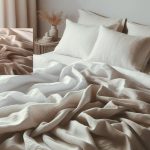It’s a coincidence that you’re curious about lightweight yet strong natural fabrics, as many are looking for sustainable options these days. You might be surprised to discover how various materials stack up against each other regarding strength, breathability, and environmental impact. From linen’s classic appeal to hemp’s eco-friendliness, each fabric has unique benefits. What are the key players in this domain, and how do they compare?
Table of Contents
Key Takeaways
- Linen is lightweight and breathable, offering durability and a stylish appearance, making it ideal for both casual and elegant settings.
- Hemp boasts superior tensile strength, is breathable, and requires minimal water, making it an eco-friendly choice for various climates.
- Ramie has a silky texture with impressive stretch resistance, ensuring durability while maintaining a beautiful drape and shape retention.
- Cotton is soft and breathable but is less durable and requires more maintenance compared to other natural fabrics.
- Bamboo is incredibly soft and breathable, perfect for sensitive skin, though its durability can vary depending on processing methods.
Linen: The Classic Lightweight Fabric
Linen, often hailed as the classic lightweight fabric, offers a unique blend of breathability and durability that’s hard to beat.
Linen is the quintessential lightweight fabric, combining breathability and durability for unmatched comfort and longevity.
You’ll appreciate how it keeps you cool during hot days while providing the strength needed for long-lasting wear. Its natural fibers allow air to circulate, making it perfect for summer clothing or home textiles.
Plus, linen ages beautifully, developing a soft patina that adds character over time. When you choose linen, you’re opting for versatility; it’s suitable for everything from casual wear to elegant table settings.
Maintenance is simple, too; just wash and line dry, and it gets even softer with each use.
With linen, you’re investing in a timeless fabric that effortlessly combines style and practicality.
Hemp: Strength and Sustainability Combined
While you might be familiar with traditional fabrics, hemp stands out as a powerhouse of strength and sustainability. This remarkable plant boasts tensile strength that’s often greater than cotton and even some synthetics, making it an excellent choice for durable clothing and accessories.
You’ll appreciate that hemp requires minimal water and no pesticides to grow, greatly reducing its environmental impact. Its fibers aren’t only resilient but also breathable, keeping you comfortable in various climates.
Plus, hemp’s natural resistance to mold and UV rays means your garments will last longer. By choosing hemp, you’re investing in a fabric that balances performance with eco-friendliness, making it a smart choice for both your wardrobe and the planet.
Ramie: The Silky Strong Contender
When you explore ramie, you’ll discover its unique silky texture that sets it apart from other fabrics.
This natural fiber offers impressive stretch resistance, making it a durable choice for your wardrobe.
You’ll appreciate how ramie combines elegance with strength, creating a standout option for lightweight clothing.
Unique Silky Texture
Ramie, often dubbed the “silk of the vegetable world,” boasts a unique silky texture that sets it apart from other natural fabrics.
When you touch ramie, you’ll immediately notice its smoothness, which gives garments an elegant feel. This soft texture makes it an excellent choice for clothing, adding a touch of luxury without the weight of traditional silk.
You’ll appreciate how it drapes beautifully, enhancing your silhouette and elevating your style. Plus, ramie’s luster adds a subtle sheen that catches the light, making your outfits stand out.
Whether you’re dressing up for a special occasion or seeking comfortable everyday wear, ramie’s silky texture offers both versatility and sophistication, ensuring you feel confident and stylish in any setting.
Stretch Resistance Benefits
Although many fabrics can stretch, few match the remarkable stretch resistance of ramie. This unique property makes ramie an excellent choice for garments that require durability without sacrificing comfort.
When you wear ramie, you’ll notice it holds its shape remarkably well, resisting the sagging and bagging common in other materials. This strength means your clothes can endure more wear and tear, saving you from frequent replacements.
Additionally, ramie’s natural fibers retain their structural integrity, even after multiple washes. So, you won’t have to worry about losing that perfect fit over time.
Its ability to resist stretching not only enhances your wardrobe but also contributes to the longevity of your favorite pieces. With ramie, you can enjoy both style and strength effortlessly.
Cotton: a Versatile Choice With Limitations
Cotton stands out as a versatile choice for many fabrics due to its softness and breathability, but it also has its limitations.
Cotton is a favored fabric for its softness and breathability, though it does come with some limitations.
While it’s comfortable and easy to care for, cotton isn’t as durable as some other natural fabrics. You might notice that it tends to wear out faster, especially in high-friction areas.
Additionally, cotton can absorb moisture, which might leave you feeling damp in humid conditions. It also has a tendency to wrinkle, requiring more maintenance than you might prefer.
If you’re looking for lightweight options with better strength and moisture management, you might want to explore other fabrics.
Nonetheless, cotton remains a popular choice for everyday wear, combining comfort with ease of use.
Bamboo: Softness With Variable Durability
When you think of bamboo fabric, the first thing that comes to mind is its incredible softness.
However, the way it’s processed can greatly affect its durability.
Understanding this balance helps you make informed choices for your wardrobe.
Soft Texture Benefits
Bamboo fabrics offer a luxurious softness that makes them a pleasure to wear, but their durability can vary depending on the processing methods used. This softness provides several benefits, such as enhanced comfort against your skin and breathability, making bamboo an ideal choice for sensitive skin or hot weather. You’ll appreciate how these fabrics drape beautifully, adding an elegant touch to your wardrobe.
| Benefit | Description | Ideal Use |
|---|---|---|
| Softness | Gentle against the skin | Activewear, loungewear |
| Breathability | Allows air circulation | Summer clothing |
| Moisture-wicking | Keeps you dry | Athletic apparel |
| Hypoallergenic | Reduces irritation | Baby clothes, undergarments |
Processing Impact on Durability
While bamboo fabrics are celebrated for their softness, the methods used in processing them can greatly affect their durability.
When you choose bamboo textiles, it’s essential to contemplate how they’ve been processed. Some manufacturers use chemical treatments that can weaken the fibers, leading to a fabric that’s less durable over time.
On the other hand, eco-friendly processes, like mechanical extraction, preserve the strength of the bamboo fibers while maintaining their softness. You’ll find that fabrics made this way can withstand wear and tear better than those processed with harsher chemicals.
The Role of Blends in Enhancing Strength
Blending natural fibers can greatly enhance the strength and durability of fabrics, making them more suitable for various applications. By combining different fibers, you can achieve unique properties that meet your specific needs. For example, cotton blends with hemp or linen often result in improved tensile strength and resistance to wear.
| Fiber Blend | Strength Benefits | Applications |
|---|---|---|
| Cotton + Hemp | Increased durability | Clothing, bags |
| Linen + Cotton | Lightweight yet strong | Summer garments |
| Wool + Silk | Softness & resilience | Luxury apparel |
| Bamboo + Cotton | Moisture-wicking | Activewear, undergarments |
| Tencel + Wool | Breathability | Eco-friendly fashion |
These blends not only enhance strength but also contribute to the overall performance of the fabric.
The Environmental Benefits of Natural Fabrics
Natural fabrics offer significant environmental benefits, especially when you consider their biodegradability and reduced carbon footprint.
Unlike synthetic materials, which can take centuries to decompose, natural fibers like cotton, hemp, and linen break down quickly, returning nutrients to the soil. This means less landfill waste and a healthier planet.
Additionally, many natural fabrics require fewer chemicals during production, minimizing water pollution and promoting sustainable farming practices.
By choosing natural fabrics, you’re also supporting biodiversity, as these materials often come from crops that coexist harmoniously with their environment.
Frequently Asked Questions
How Do Natural Fabrics Compare to Synthetic Fabrics in Strength?
When you compare natural fabrics to synthetic ones, you’ll find that natural fabrics often offer unique strengths, like breathability and comfort, while synthetic fabrics provide durability and resistance to wear. It really depends on your needs.
Can Lightweight Fabrics Be Used for Winter Clothing?
When winter’s chill bites, lightweight fabrics can still wrap you in warmth. You can definitely use them for winter clothing; just layer wisely to trap heat while enjoying their breathable, comfort-giving qualities.
What Are the Best Care Practices for These Fabrics?
To care for lightweight natural fabrics, wash them in cold water on a gentle cycle, avoid harsh detergents, air dry whenever possible, and store them in a cool, dry place to maintain their strength and quality.
Are There Any Allergies Associated With Natural Fabrics?
Yes, some people develop allergies to natural fabrics like cotton or wool. You might experience skin irritation or respiratory issues. It’s essential to test fabrics before use, especially if you have known sensitivities or allergies.
How Do I Identify High-Quality Natural Fabrics?
When you sift through a pile of autumn leaves, you can feel the difference between crisp and wilted. To identify high-quality natural fabrics, look for smooth texture, even weave, and vibrant colors—your senses will guide you.
- Does Chiffon Fabric Stink - July 15, 2025
- Does Chiffon Fabric Affect the Economy - July 15, 2025
- Does Cotton Fabric Have a Nap - July 15, 2025






